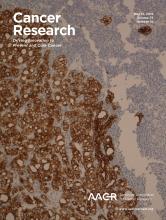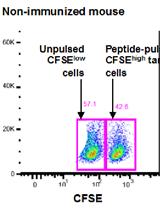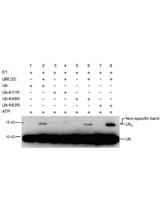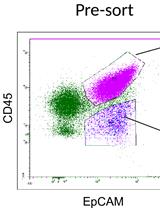- EN - English
- CN - 中文
Chromium-51 (51Cr) Release Assay to Assess Human T Cells for Functional Avidity and Tumor Cell Recognition
铬-51 (51Cr) 释放试验评估T淋巴细胞活性及对肿瘤细胞识别能力
发布: 2016年08月20日第6卷第16期 DOI: 10.21769/BioProtoc.1906 浏览次数: 19689
评审: Masahiro MoritaMichael EnosEmilie Besnard
Abstract
Cytotoxic CD8+ T cells are able to specifically recognize and kill target cells through specific interaction between their T cell receptors (TCRs) and small immunogenic peptides (antigens) presented by major histocompatibility complex (MHC) molecules. The antigen recognition capacity and in vitro lytic activity of antigen-specific cytotoxic T cells can be assessed functionally in the so-called chromium 51 (51Cr) release assay, which was developed almost 50 years ago in our institution (Brunner et al., 1968). Radioactively-labelled cells deficient for endogenous antigen presentation [e.g., transporter for antigen presentation (TAP)-deficient T2 cells] and stably transfected with the MHC of interest (e.g., HLA-A2+) are typically used as targets during this 4h assay. Alternatively, 51Cr-labelled virus-infected or tumor cell lines presenting immunogenic antigens endogenously can serve as target cells (e.g., for the assessment of tumor recognition).
In a peptide titration assay (section A), radioactively labelled target cells are pulsed with a serial dilution of the antigenic peptide and incubated at an effector (e.g., a CD8+ T cell clone) to target (51Cr -T2 cells) ratio (E:T) of 10:1 in a 96-well V-bottom plate for 4 h at 37 °C. In a tumor killing assay (section B), cytotoxic CD8+ effector cells are incubated at different ratios with the 51Cr-labelled target cell line (typically at E:T ratios of 30:1, 10:1, 3:1 and 1:1) in the presence or absence of the specific antigenic peptide (1 μM) and incubated for 4 h at 37 °C. At the end of the test, the amount of radioactivity release from the lysed target cells is determined in the supernatant using a liquid scintillation counter. The percentage of specific lysis, as well as the EC50 (i.e., 50% of maximal killing) and EMax values are then calculated, providing quantitative information about the antigen-specific functional avidity (i.e., the relative efficiency of T cell function based on antigen recognition via a defined TCR and maximal killing capacity of the analyzed T cells).
Materials and Reagents
- 96-well plates, V-shape (Corning, Costar®, catalog number: 3894 )
- 15 ml Falcon tubes (e.g., Fisher Scientific, catalog number: 14-959-53A )
- LumaPlate-96 (PerkinElmer, catalog number: 6006633 )
- Bassin or reservoir (e.g., Vitaris, catalog number: 4304-INT or equivalent)
- Antigen presenting target cells: e.g., human T2 (CRL-1992), mice P815 (ATCC, catalog number: TIB-64 ) or a characterized tumor cell line [e.g., Me275 (Zippelius et al., 2002)]
- Effector cells [(i.e., polyclonal or clonal population of antigen-specific cytotoxic CD8 T cells directly isolated from the blood of patients or healthy donors (Speiser et al., 2008)]
- RPMI 1640 (Thermo Fisher Scientific, Gibco®, catalog number: 61870010 )
- Fetal bovine serum (FBS) inactivated at 56 °C for 1 h (Thermo Fisher Scientific, Gibco®, catalog number: 10270106 )
- Antigenic peptide solution [e.g., NY-ESO-1157-165 peptide (SLLMWITQC)] dissolved in 1x PBS at initial concentration 1 mg/ml
Note: For the controls, an irrelevant peptide solution at 1 mg/ml that is not recognized by the T cells (i.e., any other class I short peptide). - 51Chromium solution (Na251CrO4) (2 ml vial containing 2 mCi at a concentration of 1 mCi/ml) (PerkinElmer, catalog number: NEZ030S002MC )
- 1 M HCl (Sigma-Aldrich, catalog number: 258148 or equivalent )
Equipment
- Multichannel pipette, 8 or 12 channels [e.g., Finnpipette F2 10-100 μl, 8 channels (Sigma-Aldrich, catalog number: Z678007 )]
- Water bath
- Incubator 37 °C, 5% CO2
- Standard laboratory desktop centrifuge for 15 ml sample tubes and 96-well plates
- Packard TopCount NXT reader (Perkin Elmer, USA)
Software
- Prism
Procedure
文章信息
版权信息
© 2016 The Authors; exclusive licensee Bio-protocol LLC.
如何引用
Baumgaertner, P., Speiser, D. E., Romero, P., Rufer, N. and Hebeisen, M. (2016). Chromium-51 (51Cr) Release Assay to Assess Human T Cells for Functional Avidity and Tumor Cell Recognition. Bio-protocol 6(16): e1906. DOI: 10.21769/BioProtoc.1906.
分类
免疫学 > 免疫细胞功能 > 细胞毒性
您对这篇实验方法有问题吗?
在此处发布您的问题,我们将邀请本文作者来回答。同时,我们会将您的问题发布到Bio-protocol Exchange,以便寻求社区成员的帮助。
Share
Bluesky
X
Copy link


















